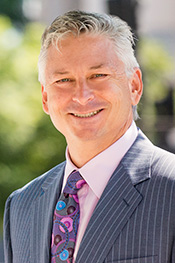By Samantha Henry
Innovation and efficiency were major themes of an economic outlook hosted by San Diego State University’s Lavin Entrepreneurship Center and moderated by Stuart Sorenson of Duane Morris LLP.
As the economy rebounds and challenges emerge, successful companies will learn to innovate and be more efficient with what they have.
Businesses can also look to indicators of the market, like the real estate industry, which can signify job growth and increased business loans.

“If you see space being absorbed, that tells you jobs are being created,” said David Marino, executive vice president at Hughes Marino.
The economy bottomed in 2010 and started to recover in the second half of 2010, but it was so slight that it couldn’t be felt, Marino said, and it wasn’t until 2013 that it started to feel like a “breakaway year.” Last year there were 3.3 million square feet of space absorbed in San Diego County, he said, up from 2.7 million in 2012 and 2.2 million in 2011.
Marino said there’s “exciting momentum” going into 2014 — about 80 percent of the projects from last year were for 2014 occupancies and 20 percent for 2015. About 80 percent of those projects are companies expanding and taking up more space, 15 percent are staying flat and 5 percent are shrinking.
There are a lot of “bright spots” and no industry is in turmoil, Marino said. Law firms are flat, but life sciences are going through “quite a recovery.”
Looking at 2014, Marino said he’s happy with “slow and steady” and if the trajectory continues, he’ll be thrilled.
“The real estate market has come back and it has come back very, very strong,” said George Hadjis, founder and CEO of Oggi’s Pizza and Brewing Co.
When the real estate market strengthens, it not only creates jobs for those who build houses, but also gives banks better collateral for lending, Hadjis said.
“When they lend more, more businesses open and the cycle begins again,” Hadjis said.
Last year was an “interesting” year for Hadjis, he said.
“We formed a base from which we continued to expand within each of our stores. That was the result of two to three years of central examination of products and services, and a major effort on our part to modernize our concept,” Hadjis said.
“During the years of the Great Recession, we placed all efforts inward to improve the menu, what we looked like, to modernize and to make a new customer base to follow the aging customer base.”
Hadjis listened to his customers’ comments and designed a new look for the stores while emphasizing what they’re interested in: beer, pizza and sports. In 2014, Oggi’s is opening an experimental fast-casual store on the SDSU campus with a goal to introduce Oggi’s to a younger customer, seeding the future for the company and franchisees.
A store that had closed in Vista will reopen, which Hadjis said is a “positive sign for our industry.” Interest in new franchise stores is greater than ever before, he said, which isn’t all attributed to the great pizza — a lot has to do with the economy getting better.
Different variables will affect how 2014 plays out, and some of those include the Affordable Care Act and the increase in minimum wage, Hadjis said. Some of Oggi’s franchisees are not looking to expand or are shedding stores to stay under the limit for the ACA, he said.
“That to me is telling,” Hadjis said.
Susan Salka, CEO, president and director of AMN Healthcare Services Inc. (NYSE: AHS), said trends in the health care industry show many competing forces. There are more challenges, change and opportunities than ever in the health care industry, she said, with decades of transformation jammed into five to 10 years.
The industry navigated through health care reform’s initial changes in 2013, and bigger changes are expected in 2014, creating a “tremendous amount of uncertainty,” Salka said. Last year started strong in all business lines, but as the year continued, Salka said the demand for clinical labor declined, as well as the number of job openings.
“December was the first month in a decade that health care was net negative in the number of jobs added. That was quite an awakening,” Salka said.
In five to 10 years there will be a great demand and need for services, and the shortages of clinicians will be “severe,” she said. Many of AMN’s clients are in a limbo stage because they need more clinicians and need to expand services, but don’t have the money to do so.
“That uncertainty has created challenges, but also opportunity,” Salka said, adding that companies can find value by lowering the cost of care and increasing quality.
Hadjis said he thinks people will do well if they “investigate and pursue innovation.”
Salka agreed, stating that innovation will be the key to success, whether at a restaurant or heath care company. Innovation, whether producing something that no one else has or finding a way to do something more economically, drives San Diego’s economic engine, Salka said.
Evolution “catapulted” AMN from 19 employees when Salka joined in 1990 to 2,000 corporate employees today.
Finding a way to increase staff efficiency in delivering care and providing technology will help companies succeed, Salka said.
Increasing efficiency will also be important when the minimum wage is raised to $9 an hour in July.
“We need to find ways to become more efficient with the labor we have under our roof,” Hadjis said. Technology and training will be key to increasing efficiency, he added.
There will be fewer jobs when the wage is raised, said Jerry Sanders, president and CEO of the San Diego Regional Chamber of Commerce. Jobs will also be lost if companies decide not to expand in San Diego, which could happen as a result of the linkage fee.
The linkage fee, which the city charges developers to help fund affordable housing, makes San Diego “noncompetitive in the job market,” Sanders said. It has stopped people from thinking about the city for expansion or location, he added, sending them to Carlsbad, Escondido or San Marcos.
Recent graduates and current students were in the audience Tuesday night and asked about their future in the job market. Salka suggested they find internships and work their way up in the company, and said they should look for companies that are investing in growth.
Sanders said because of the hit that 401(k)s and retirement funds took, people aren’t leaving the job market, which shuts off opportunities for recent graduates.
Marino suggested graduates find companies that excite them and make themselves stand out by sending a personal letter.
“There is too much talent looking for too short a supply of jobs,” Marino said.
This article originally appeared in The Daily Transcript.
David Marino is senior executive vice president of Hughes Marino, a global corporate real estate advisory firm that specializes in representing tenants and buyers. Contact David at 1-844-662-6635 or david@hughesmarino.com to learn more.










